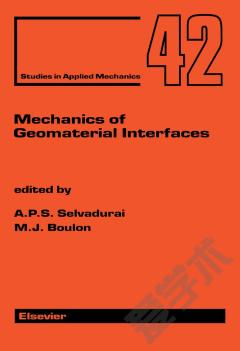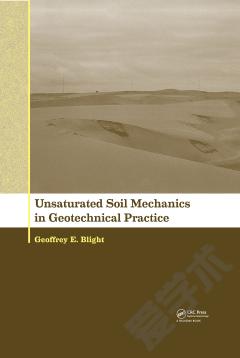Mechanics of Unsaturated Geomaterials
An understanding of the mechanics of unsaturated geomaterials has become an important component of the background of a geo-engineer operating in various fields of geomechanics. Several geotechnical operations, such as compaction and excavation processes, are linked to the mechanics of unsaturated geomaterials. As more than one-third of the earthâs surface is arid or semi-arid, in addition to the less extreme cases of seasonal droughts and diurnal variations of the water table in soils, it is obvious that most soils and rocks are in a general state of partial water saturation. In other words, the pore space within geomaterials (e.g., soil, rock and concrete) is generally filled with water and air. That means that the mechanics and physics of the considered material are those of a three-phase material: solid mineral and two immiscible fluid phases. Even though most natural and engineered geomaterials are only partially saturated with water, a persistent assumption made in geomechanics and geotechnical engineering over the past decades has been the assumption of complete saturation. The study of the mechanics of unsaturated geomaterials was initiated approximately 50 years ago as a natural extension of the knowledge developed in the conventional areas of the mechanics of (saturated) soils and rocks. The mechanics of saturated geomaterials is primarily based on the concept of effective stress and on the consolidation theory. In the hydromechanical frameworks for saturated materials that have been developed, the pore fluid (water) pressure mainly contributes to the mechanical behaviour through the field equations (consolidation theory). Its contribution to the constitutive behaviour of the solid skeleton is considered âneutralâ (no effect of the pore fluid pressure on the effective material compressibility or strength, for instance). When this particular assumption about materials saturated with a fluid under compression was no longer considered valid, the conventional theories needed to be revised. This was the first major development in defining the mechanics of unsaturated materials. The field equations were found to need an extension to address the effect of the degree of saturation on water permeability and on compressibility; the gas flow also had to be considered in some situations. The solid skeleton constitutive behaviour must incorporate the effect of the gas pressure, or more specifically, its difference with respect to the liquid pressure, known as suction. In addition, the extension of the effective stress concept to the unsaturated conditions revealed a need to take into account the important contribution of the water retention behaviour, linking the degree of saturation to suction. In the last decade, the advancement of knowledge regarding the mechanics of unsaturated geomaterials has been significant. Some fundamental issues were solved, and important achievements were made in certain areas, including application of the effective stress concept and measurement of volume variations. The multiphysical interactions were then extended to non-isothermal conditions. This spectacular progress in the field also included engineering applications. In many cases, new tools were developed, and advanced analysis became possible. The objective of this book is to supply the reader with an exhaustive overview on new trends in the field of the mechanics of unsaturated geomaterials, starting from the basic issues and covering the most recent theories and applications (i.e., natural disasters and nuclear waste disposal). The presentation of the fundamental concepts is based on an interdisciplinary approach and includes chapters on the topics of soil-, rock- and cement-based mechanics. The book begins with the introduction of several fundamental notions concerning the mechanics of unsaturated materials. Basic concepts about the state of water in soils are presented in Chapter 1, and Chapter 2 introduces the concepts of mechanics in unsaturated geomaterials. Chapter 3 reviews the phenomenon of soil cracking during soil desaturation. The second part of the book is devoted to experimental techniques that allow testing of soils and rocks in unsaturated conditions. Chapter 4 reviews the techniques for controlling and measuring suction and presents mechanical testing devices. The characterisation of highly overconsolidated clayey unsaturated materials is presented in Chapter 5. Field measurement techniques (of suction, water content and water permeability) are presented in Chapter 6. In the third part of the book, the main theoretical concepts are established. The numerical treatment of the field equations is emphasised, with special attention devoted to the analysis of the strain localisation in coupled transient phenomena. The conservation laws in unsaturated porous materials are discussed in Chapter 7, while the hydromechanical coupling theory and its numerical integration methods are presented in Chapter 8. Strain localisation in coupled transient phenomena is the topic of Chapter 9. The fourth part of the book presents engineering applications that show the importance of the mechanics of unsaturated geomaterials in many fields of practical interest. Numerical modelling of landslides is investigated in Chapter 10. Moisture transport and pore pressure generation in nearly saturated geomaterials are the main topics of Chapter 11. Chapter 12 deals with application to nuclear waste storage. Chapter 13 reviews experimental results and modelling of soil-pipeline interactions. The engineering behaviours of different unsaturated zones are described in Chapter 14, where the modelling of consolidation and swelling in fine soils is also considered. River embankments are geomechanically analysed in Chapter 15. This book was written for postgraduate students, researchers and practitioners in fields where unsaturated conditions play a fundamental role, such as soil mechanics, soil physics, rock mechanics, petroleum engineering, hydrology and nuclear waste engineering. I would like to express my appreciation to all of my colleagues who chose to contribute to this book. Special thanks are due to Prof. Tomasz Hueckel and Prof. Felix Darve for their encouragement, which made the book possible. My thanks are also directed to the Alert Geomaterials network that supported this initiative.
{{comment.content}}








 京公网安备 11010802027623号
京公网安备 11010802027623号